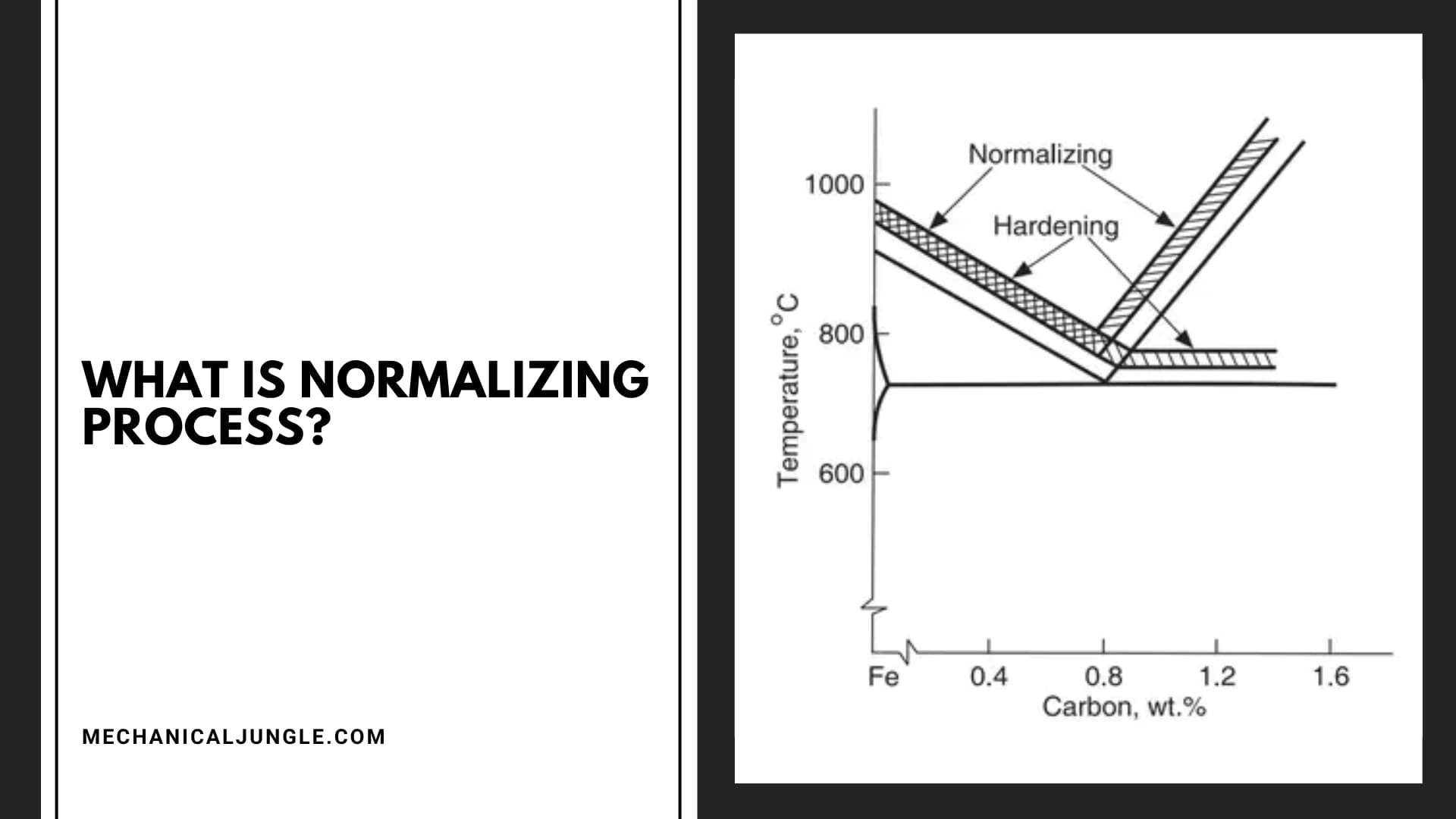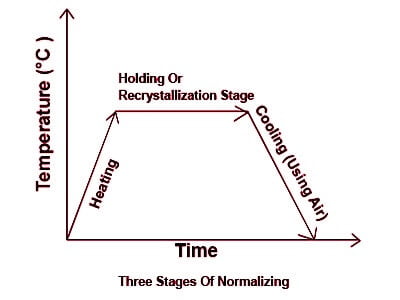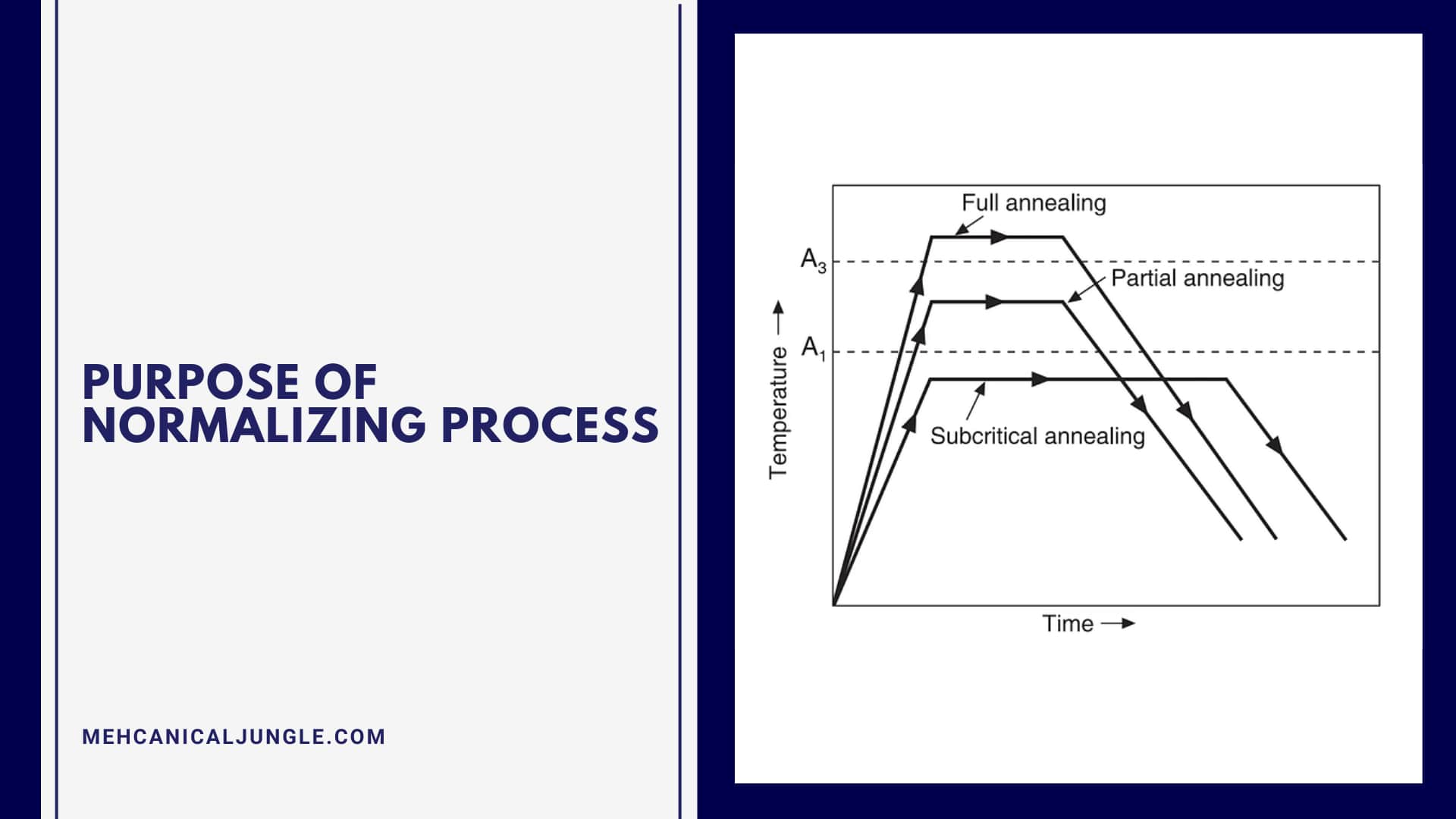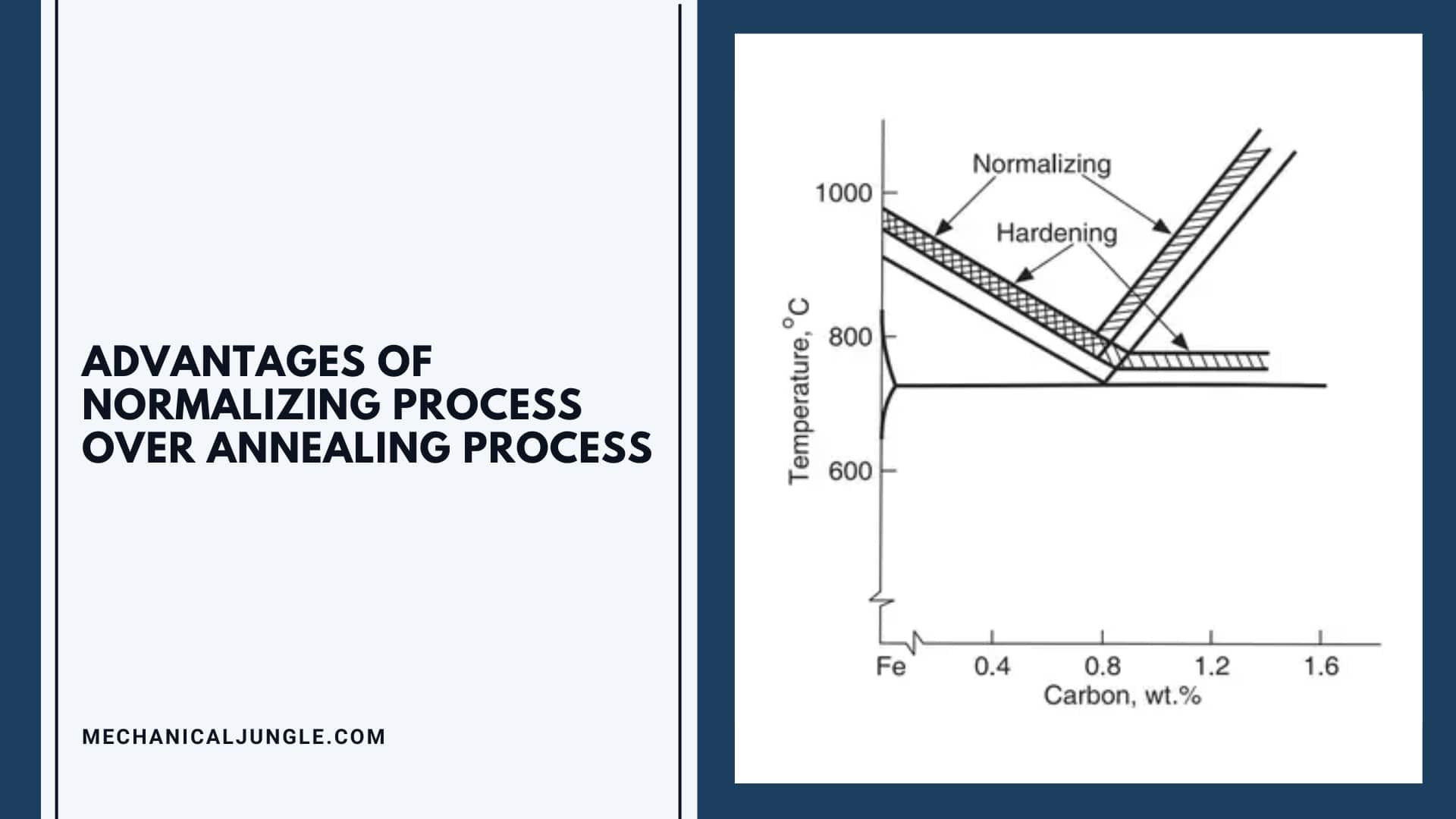Important Point
What Is Normalizing Process?
Normalizing is a heats treatment process used to make a metal more ductile and harder as it is subjected to thermal or mechanical hardening processes. Normalizing involves heating a material to elevated temperatures and then allowing it to cool to room temperatures by exposing it to room temperature air after heating. This heating and slow cooling change the metal microstructure, which in turn reduces its hardness and increases its ductility.
Normalizing is a heat metal process that alters metal properties such as tensile strength, ductility and also refines the grain structure. It is the type of heat treatment that applies only to ferrous metals. In the Normalizing process, the material is heated to an elevated temperature, and after that, it is cooled by keeping in contact with air at room temperature. This process of cooling the metal with air is called air quenching.
This Normalizing process alters the microstructure of the metal, leading to increased ductility and increased hardness of the metal. Normalizing is needed because flexibility is reduced, and stiffness is increased by various processes such as a hammer.
It is commonly used to change the mechanical properties of metal so that it becomes easily serviceable and can be fully machined.
Since heating is performed above the upper critical temperature range, it automatically softens the steel as heating is carried out to a supporting state, and softening of the steel automatically relieves the lock-in stress, which in turn reduces residual stresses.
Normalizing is usually done after forging or casting. Cold work and casting are manufacturing processes that produce grain structure that may need to be normalized before the component is put into service. Normalizing provides relief from internal stress caused by cold.
In this process, heating is done in the air, so subsequent machining or removal of scale or decarburized layers is required to eliminate the surface.
Normalizing Process Procedure:
- Recovery stage.
- Reconstruction stage.
- Grain growth stage.
#1. Recovery stage
In the recovery stage, a furnace or other heating device is used to raise the temperature of the material to such an extent, where its external stresses can be relieved. This causes the structure in the material as a whole.
#2. Reconstruction stage
In the reconstruction stage, the material is heated above the re-crystallization temperature but below the melting temperature, which forms a new grain without straining. In this phase, the material is held at a constant temperature for some time for the formation of grains.
#3. Grain growth stage
During this stage, new grains are fully developed. The growth of the grain of the material is controlled by allowing the material to cool to room temperatures by placing it in the air. In thises process, the rate of cooling is higher than in the annealing process.
This cooling is non-equilibriums cooling. Due to the faster rate of cool, we find a more refined grain structure than annealing.
After these three steps, the ductility of the material increases, and its hardness decreases. Also, the material becomes more mechanized.
Purpose of Normalizing Process:
- To improve Machinability:- Various machining processes such as facing, taper turning, boring drilling can be easily performed after the normalization process.
- To modify and refine Cast dendritic Structure:- We can modify defects that occur after a casting-like process.
- To refine the grains:- It is used to refines the grain structure that changes some of the mechanical properties of metal.
- To make the materials suitable for further heat treatment:- The material is designed for further heat treatment like a hardening process.
- To overcome the internal stress of the materials.
- To improve the tensile strength of the material.
Only those metals can be normalized whose microstructure can be replaced by heat treatment.
The list of metal and alloys which can be normalized are:-
- Copper.
- Iron-based alloys such as tool steel, carbon steel, stainless steel, and cast iron.
- Brass.
- Aluminum.
- Nico-based alloys like Nilo 6 * and Pernifer 6 *.
Advantages of Normalizing Process Over Annealing Process:
- It is fasters than the annealing process as the rate of cooling is faster than the annealing process because, in normalizing, the materials are cool by placing it at room temperature, while in annealing, the material is cooled at a controlled rate in a furnace.
- The quality of surfaces after machining of a normalized part is also better than in an annealed part.
- Quenching media are air, i.e., outside the furnace, so it becomes batch type production.
- Normalizing is fewer expensive than annealing because it does not require additionals furnace time during the cool-down process.
Limitation of Normalizing Process:
- As the cooling rate during normalizing in steel may be different at different depths, the structure houses formed is dependent on the thickness of the steel part.
- Increased rate of cooling in normalizing results in high hardness and low ductility than annealing.
Applications of Normalizing Process:
Normalizing is used for many different materials in many different industries. Examples include:
- Ferritic stainless steel stamping in the automotive industry can be normalized after the hardening of work that occurs during their manufacturing process.
- Nickel-based alloys in the nuclear industry can be normalized after thermal microstructure changes that occur after welding.
- After cold-rolled, carbon steel can be normalized to reduce the brittleness caused by work hardening.
Frequently Asked Questions (FAQ)
Normalizing Heat Treatment
Normalizing heat treatment helps to remove impurities and improve ductility and toughness. During the normalizing process, the material is heated to between 750-980 °C (1320-1796 °F). The exact heat applied for treatment will vary and is determined based on the amount of carbon content in the metal.
Steel Normalization
Normalizing involves heating the steel to an elevated temperature, followed by slow cooling to room temperature. The heating and slow cooling change the microstructure of the steel. This reduces the hardness of the steel and will increase its ductility.
Normalizing Process in Heat Treatment of Steel
Normalizing involves heating a material to an elevated temperature and then allowing it to cool back to room temperature by exposing it to room temperature air after it is heated. This heating and slow cooling alters the microstructure of the metal which in turn reduces its hardness and increases its ductility.
Steps Involved in the Normalizing Process
- Recovery stage.
- Recrystallization stage.
- Grain growth stage.
Benefits of Normalizing Steel for Improved Properties
Normalizing is a heat treatment process used to improve the mechanical properties of steel. By subjecting the steel to controlled heating and cooling cycles, normalizing helps to achieve a more uniform microstructure and enhances its overall properties. Some of the key benefits of normalizing steel include:
- Improved mechanical properties: Normalizing helps to refine the grain structure of the steel, resulting in improved mechanical properties such as increased strength, hardness, and toughness. It can make the steel more suitable for applications that require higher structural integrity and resistance to external forces.
- Enhanced machinability: Normalizing steel can improve its machinability, making it easier to shape, cut, and machine. It reduces the hardness and brittleness of the material, allowing for more efficient and precise machining operations.
- Stress relief: During the manufacturing process, steel can develop residual stresses due to uneven cooling or deformation. Normalizing helps to relieve these internal stresses by heating the steel to a critical temperature and allowing it to cool slowly. This stress relief can prevent distortion, cracking, or premature failure of the material.
- Uniform microstructure: Normalizing promotes the formation of a uniform microstructure throughout the steel. It eliminates or reduces the presence of undesirable phases or structures such as non-uniform grain sizes, inclusions, or precipitates. This leads to a more consistent material with predictable properties.
- Improved response to further heat treatments: Normalizing can prepare the steel for subsequent heat treatments such as hardening or tempering. By refining the microstructure, it allows for more controlled and effective heat treatment processes, resulting in the desired material properties.
Normalizing Vs. Annealing: a Comparison of Heat Treatment Methods
The main difference between annealing and normalizing is that annealing allows the material to cool at a controlled rate in a furnace. Normalizing allows the material to cool by placing it in a room temperature environment and exposing it to the air in that environment.
Normalizing Process Parameters and Best Practices
The process parameters and best practices for normalizing steel can vary depending on the specific type and composition of the steel, as well as the desired outcome. However, here are some general guidelines and best practices for normalizing steel:
- Heating temperature: The steel is heated to a temperature above its upper critical temperature, which is typically between 800°C (1470°F) and 950°C (1740°F), depending on the steel grade. It is important to select the appropriate heating temperature based on the steel’s composition to ensure proper transformation and grain refinement.
- Soaking time: Once the steel reaches the desired temperature, it should be soaked at that temperature for a sufficient period. The soaking time depends on the thickness and size of the steel. As a general rule of thumb, a soaking time of approximately one hour per inch of thickness is commonly recommended.
- Cooling method: After the soaking period, the steel is cooled in still air or placed in a furnace for slow cooling. The cooling rate should be relatively slow to allow for proper transformation and to minimize the risk of distortion or cracking. It is important to avoid rapid cooling methods like water quenching, as they can lead to excessive hardness and brittleness.
- Uniform heating and cooling: It is crucial to ensure uniform heating and cooling of the steel to achieve consistent results. This can be achieved by using a properly calibrated furnace with uniform heat distribution or employing techniques such as furnace rotation or fan circulation to maintain even temperature throughout the steel.
- Surface preparation: Before normalizing, the steel should be cleaned and free from any contaminants like oils, scale, or dirt. This ensures proper heat transfer and prevents surface defects.
Purpose of Normalizing Is
Normalizing imparts both hardness and strength to iron and steel components. In addition, normalizing helps reduce internal stresses induced by such operations as forging, casting, machining, forming or welding.
Normalizing Is a Process of Heat Treating
Normalizing is a heat treatment process that is used to make a metal more ductile and tough after it has been subjected to thermal or mechanical hardening processes.
Normalizing Process of Steel
Normalizing involves heating the steel to an elevated temperature, followed by slow cooling to room temperature. The heating and slow cooling changes the microstructure of the steel. This reduces the hardness of the steel and will increases its ductility.
Normalizing Vs Tempering
Tempering is typically used on steels that have been hardened, while normalizing is typically used on steels that have not been hardened. The main difference between tempering and normalizing is that tempering increases the hardness of steel, while normalizing increases the ductility of steel.
Like this post? Share it with your friends!
Suggested Read –
- Nuclear Power Plant Components
- Parts and Functions of Grinding Machine | Grinding Machine | Grinding Machine Types
- Parts of Cornish Boiler | Working Principle of Cornish Boiler | Construction of Cornish Boiler
- Parts of Air Lift Pump | Working Principle of Air Lift Pump | Advantages of Air Lift Pump | Disadvantages of Air Lift Pump
- Pattern Allowances In Casting | Why the Pattern Allowances In Casting Affected | Finishing or Machining Allowance | Shake or Rapping Allowance
- Difference Between Air Conditioning and Refrigeration Why We Need a Refrigeration | Refrigeration System | Refrigeration Cycle | Principle of Refrigeration







Leave a Reply